


On this page:
- 2000
- 2001
- [April 2001] Gardening in the park
- [May 2001] Garden news
- Resolution of stand-off with the Parks Department maintenance crew
- [June 2001] Garden news
- [July August 2001]The mystery of the mushrooms: solved
- [July- August 2001] Arie and the high school students
- [Sept.2001] Grapes
- [Nov.2001] Garden news
- 2002
2000
[September 2000] Gardens:

early garden
This year the plentiful rain started the gardens off well, and of course the efforts of Arie Kemp yielded wonderful results, as he grew the most striking flowers from seed all over the park. Arie collects seed from the best stands of flowers that he can discover on his bike rides around the city. These seeds are for sale at the rink house, with instructions on planting (50 cents for a generous envelope). Arie says the fall is the best time for scattering the native and perennial seed he has available. He says, don't cover such seeds at all, just tamp them gently with your foot, so they can make contact with the earth.
Gene Threndyle's marsh garden grew more lush than ever, with a good number of vigorous bright red cardinal flowers. Gene was nominated for a City of Toronto "Neighbourlies" Award for the fountain. Gene's small tree nursery near the field house is also growing very well. A note to dog owners: please keep your dogs out of these areas so they don't damage the plants.
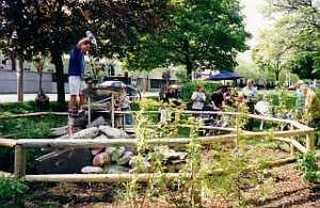
Marsh Garden
At the request of Councillor Silva, the city is manufacturing some attractive signs, with photos of the old days, giving information on the kinds of plants growing in the native species areas.
Annick Mitchell grew a demonstration vegetable garden with heritage seeds and many different varieties of potatoes. For next year there is still garden space available for people whose green thumb is itchy. Call Lily at the rink house to find out more.
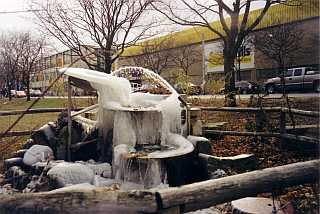
An Ice Fountain by the Garden
[November 2000] Gardening news:
1. Spring bulbs from our "Fairy Godmother," for the fourth year in a row: Pat MacKay (who has helped the park out in small and large ways ever since she first set eyes on us six years ago - not because she lives nearby but just because she likes what happens here) brought over five big bags of spring bulbs. The Parks department stopped planting flowers in Dufferin Grove Park in 1993, and all the tulips and daffodils that are in the park now come through Pat's generosity. This year Arie Kamp planted most of the bulbs in his new sweeping flowerbed in front of the rink house, but we've saved two bags to take over to Christie Pits and plant around the new bake-oven there.
2. Wild roses for the southwest garden: Councillor Silva told us this summer that he had got some unhappy phone calls about the wild appearance of the southwest native-species flowerbed. Part of the problem was the overly lush growth caused by this years abundant spring rains, and part was the crushing of the plants by people wading right into the flowerbed. This fall we got a donation of forty wild rose plants from Brian Green of the Parks Department, and planted many of them down there. We hope that the blooms will be beautiful in spring and early summer, and the thorns will be scratchy for flowerbed invaders.
2001
[April 2001] Gardening in the park:
Arie Kamp has started to dig some new flowerbeds near the rink area. He's also replacing some of the boards that surround his raised beds. Every year there is some rot, especially because Arie uses mostly old boards he finds at construction sites (his motto is "waste not, want not"). Gene Threndyle will be working with some park workers in the middle of April to put a small farm fence around the southwest native-species garden near the bus shelter on Dufferin Street. That garden suffers the most from blowing trash and night-time visits from people seeking shelter. Using last winter's $500 grant from the movie industry (brokered by Councillor Mario Silva), Gene will be replacing some of the plantings with small flowering bushes such as chokecherry and wild plum, as well as wild rose bushes. He will also experiment with the use of log cross-sections (sections of a large maple recently cut at our park) to make the inside of the flowerbed uneven and therefore less comfortable for sleeping or other night-time activities.
[May 2001] Garden news:
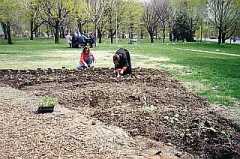
The making of the first triangle garden
Where to get the best plants: This neighbourhood is fortunate in having the wonderful plant outlet at Fiesta Farms Garden Centre. The selection of perennials and native species is spectacular. Everything we've bought there, when the park had garden money, has done well. The perennial manager is Margaret Serrao, and her number, if you want to ask her anything, is 416/537-1244, ext.130. (This is not paid advertising for the garden centre, and the nursery has never given us any free stuff, but we just think they are terrific.)
Resolution of stand-off with the Parks Department maintenance crew:
We found out this spring that the parks department maintenance crew felt that when a garden is put in a park by volunteers, it is no longer the city's responsibility to maintain that area. This means that often trash was not picked out of the community flower beds by city workers, and it also means that if a volunteer gardener came and weeded a garden and puts the weeds in a pile beside the garden, the city workers were told not to pick up the pile.
The volunteer gardeners are already offering their time as a gift, so it's not always realistic to tell them that they must also drag their clippings to the edge of the park for pick-up. (Despite what anyone fantasizes about "community participation," remember that there are only really five people who do any gardening in the park, with Arie doing the lion's share of work - with all those gardens). Since the city staff already move around the park with their truck picking up garbage anyway, it seemed to us that they could pick up the weed piles too. Because of our disagreement, two big piles of weeds and trimmings lay near the wildflower signs for four weeks. It was a stand-off.
But now the good news: at the beginning of May, the maintenance workers came and picked up the weeds and trimmed stalks. The grass is beginning to recover where the piles lay.
[June 2001] Garden news:
Annick Mitchell planted one of the park's triangle vegetable gardens. She says: " In early May I planted a whole lot of stuff...peas, herbs, lettuce, Swiss chard, and of course POTATOES. A week later I added peppers and tomatoes. I had to replant three of the tomato plants because somebody stole them. I decided to try irrigation trenches the way they do in Spain, where my sister lives, for the peppers and the onions. My son Ben likes this garden because it's all in neat rows. He and his brother Jake and Kate(his girlfriend) helped me dig and plant the garden as their mother's day present...sweat presents."
Jutta Mason planted the other triangular vegetable bed. Everything is doing well, including the plentiful coriander that replanted itself from last year. The bed includes both domestic and wild vegetables (lamb's quarters, amaranth - see recipe section), and it will have succession plantings this year, to keep the pizza days and the special events days well supplied.
Arie Kamp planted out most of the bedding plants (the rink garage was full of flats) from High Park greenhouse. He hardly had to water them, there's been so much rain. Arie is unhappy about people walking or riding their bikes through his garden beds, crushing the flowers. He has added some barriers, although he thought better of putting boards with nails (pointing up) in amongst the flowers. There are some liability issues to such an approach.
Destruction of plants is - happily - rare at our park, but it still hurts when you see the evidence.
Native-species gardens:
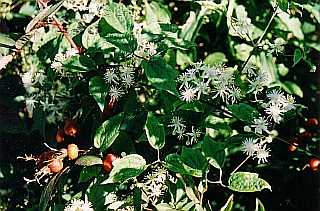
Native-species Gardens
The test meadow: just west of the large bake oven there is a small patch of high grass with shasta daisies, calendula, brown-eyed Susans, coneflowers, blue flax, blanket flower, and some coreopsis. This is an attempt to make an old-fashioned (but not native-species) flower meadow that will stabilize and re-seed itself (in the case of self-seeding flowers). Arie Kamp seeded the area and Jutta Mason has been trying to reduce dandelion, shepherd's purse, and plantain to prevent these plants from choking the flowers.
Parkdale and Toronto Horticultural Society Garden Tour, June 3. This yearly west-end garden tour will visit the park for the first time ever this year, with a stop at the pizza oven for some lunch.
Grass-cutting troubles: For those park users who have commented on the high grass in different parts of the park, we asked Mike Hindle, the park grounds supervisor, to explain. He said that he has once again been assigned a smaller crew than last year; that they have had troubles with machinery break-down; that at this time of year they have to give priority to sports fields; and that because of the rain the grass is growing very fast now. He says the next major mowing may not be until mid-to-late June.
Mushrooms in the park: After it started to get rainy in May, Shirley (who walks the dog Sally) found a large number of mushrooms growing near the wildflower sign, under the big maples. When we consulted Jimmy Longo of Longo's Groceries, he said they might be the same kind as you buy in the store. We need a park mushroom expert. If you know how to distinguish mushrooms and are willing to tell us at the park, please call Johanne at the rink house: 392-0913.
[July August 2001]The mystery of the mushrooms: solved.
The mushrooms that Shirley the dog walker found in the park and the Italian card players said were edible have a name: Agarius bitorquis, a.k.a. "sidewalk mushroom." The authoritative guide to local mushrooms, "Mushrooms of Ontario and Eastern Canada" by George Barron, says these mushrooms are very common, are edible, and favour hard-packed soil. That's certainly true for the park - they were found near the wildflower sign, by Dufferin Street, where the ground seems far too hard to even allow mushrooms to come up. But there they were, for a couple of weeks in late Spring. Hopefully they'll come back in the fall - they were delicious.
[July- August 2001] Arie and the high school students:
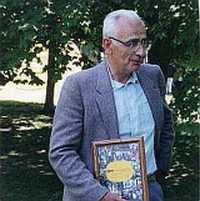
Arie Kamp receiving an award
Arie Kamp, who does most of the flower gardens at the park, also puts flowers in front of St.Mary's High School. This summer the school has over a thousand summer students, from all over the city, and many of them have no previous connection to the park or to Arie. Some of the students, during their lunch hour, stomp on Arie's flowers, by accident or on purpose. This makes Arie very angry, and sometimes he shouts at the students. Usually the students stop, but a few of them just stomp on the flowers more, at the school and across the street at the park. Arie is so discouraged that he has considered painting some graffiti on the school: "school for wild animals." Although some in the neighbourhood might cheer at such a sign, we think it would be sad for Arie to spend his old age in jail for defacing school walls. The summer school principal has promised to station a staff person outside the school to monitor the kids' behaviour. Neighbours can help - if you see flower vandalism, ask the vandals to stop. Sooner or later, they'll grasp the concept.
Patience with the grapes, please: This is the third year we've had the grape vines that Ben Figueredo planted up by the rink's chain link fence. There are many, many grapes this year. They'll be ripe in the early fall. Ben wants to post a sign by the grapes, asking people to be patient and wait until the grapes are really ripe before sampling. He says if you eat them too soon, they're sour and nasty, but if you have patience, they are absolutely delicious.
[Sept.2001] Grapes:
Ben Figueredo's grapevines, on the chain link fence at the rink pad, grew many little bunches of purple grapes (Ben says they're small because of the drought). Long before Ben said they were ripe, they were already delicious, and the only ones left by now are high up. Some have been used to make a different kind of sourdough starter for bread - there is natural yeast on grape skins just as there is on the outside of wheat. Anyone who wants to taste the grapes, hurry and sample some before they're all gone. And sourdough starter is available.
[Nov.2001] Garden news:
Arie Kamp has dug up Pat MacKay's tulip bulbs from the little native tree nursery by the field house, and replanted them by the path to the north of the hockey rink, where they'll make a good show before his famous Shirley poppies come on. Julie Caniglia of New York's Project for Public Spaces sent the park a gift certificate for scylla bulbs, in appreciation of some information PPS featured on their web site last May (about cooking with fire in parks). Scylla are the bright blue flowers that come up in the early spring. They multiply quickly and can turn a lawn into a lake of blue flowers. They've been planted near Lisa Shizgal's wildflower sign, on the banks of the former Garrison Creek. Hopefully they will do well and flow down the hillside like water.
2002
[March 2002] Gardening news:
By the last week of February the tulips were up two inches in front of the rink house. At the same time, in the garden beside the ovens, the arugula was still growing from last fall. And when students from Ursula Franklin Academy came to skate and make flatbread in the oven, they were able to use fresh garden sage on their herb breads.
On February 22, Rhonda Teitel-Payne from Stop 103 (the innovative "food centre" on Davenport near Lansdowne) joined Arie Kamp and rink staff member Jenny Cook to bag Arie's seeds at the rink clubhouse for the second annual Seedy Saturday (March 2 at Scadding Court Community Centre). Arie donates masses of the seeds he gathers in the fall, to help raise funds for this gardening fair. And he still has enough California Poppy seed left to cover half the city. If you want to get some (50 cents a bag), call the rink clubhouse at 416/ 392-0913 and leave a message.
Alan Gasser, director of the Darbazi Choir, and his wife Becca, have donated $50 to the park, in appreciation of the choir having the rink clubhouse as their Sunday night rehearsal space. This money will be used to order this season's supply of vegetable seeds and seed potatoes. This year we'll try to grow more pizza herbs, salad stuff, and root vegetables for use in the ovens. If you have a green thumb (or want to get one) and are interested in gardening at the park, call the rink clubhouse at 416/392-0913 and leave a message.
[May 2002] Pansies, primulas and water cannons:
Our yearly shipment of pansies and primulas from the High Park greenhouse arrived just before the April heat wave. Arie Kamp spent many hours planting them out, quickly, so they wouldn't get leggy as they did last year. When the heat came, some of the high school students got a bit reckless, and they stepped on Arie's plants, on purpose. He consulted the principal at St.Mary's High School, and one of the perpetrators got nailed. But a few days later, a group of students stood in Arie's flowerbed to write chalk graffiti on the club house wall.
That did it. Arie was watering the pansies at that moment, and he turned his thick black hose on the students and wet them right through. They were really mad, and stood on the other side of the street taunting him. Arie appealed to the Italian and Portuguese card players inside the club house to come out and help him, but they refused, saying they didn't want to get hurt. When some of the wet youth tried to come near, Arie waved a hockey stick at them, and they backed away again. Finally, after half an hour, they moved down to the bus shelter. Arie said: "I will not let them get the better of me. I was a corporal in the army and I know how to stand my ground."
And indeed he does. We can't help but wonder, though - if Arie had managed to persuade the old card players to join him - all of them, including Arie, in their seventies - and the two sides had faced off across Dufferin Park Avenue, would City TV have brought out their mobile TV crew and filmed the battle?
[May 2002] Spring in the park gardens:
The four wild plum bushes planted last year in the native-plants areas by Gene Threndyle all survived their first winter, and they look good. We have a new donated high-bush cranberry beside the wildflower sign, and a new donated wisteria vine by the chain link fence near the ovens. A willow appeared last fall near the marsh fountain, planted by a mystery person, and it's been moved a little further away from the existing gardens so that it won't cast too much shade, but it looks strong. As for wildflowers - lavender-white hepaticas are in full bloom, as are the white "dutchmen's breeches." The trilliums are about to open, and the wild iris have shown leaves but no flowers yet.
Jutta Mason planted four stinging nettle plants in the tree nursery near the field house, partly for food (they are delicious greens) and partly to discourage people from sleeping there in future (nettles REALLY sting before they're cooked).
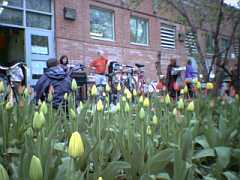
Pat MacKay's tulips
Spring bulbs: most of the tulips in the park were originally donated by Pat MacKay, a steadfast friend to the park. Pat also gave us the daffodils. Last fall Arie Kamp tried to dig up the bulbs and relocate them away from the wildflower beds (they were planted there by mistake - they're Dutch, not native Canadian). So there are lots of tulips and daffodils in the playground gardens and in front of the rink house now, but there are ALSO lots still left in the wildflower gardens - the ones that eluded Arie's spade. Pat MacKay bought the kind of bulbs that would multiply - and they have. In addition, a new friend from New York at the Project for Public Spaces gave us some scylla bulbs last year, which have been planted on the hillside near the wildflower sign and will hopefully multiply enough to turn the hill blue in future springtimes. (Arie started planting violets on that hillside a few years ago and they didn't seem to be doing very well, but now the hill is thick with violet plants, not yet in bloom - take a look in a few weeks).
We have a new community gardener, Caitlin Shea, who called Foodshare wanting somewhere to plant and was referred to us. Despite Arie Kamp's enormous energy, there's room for more helpers. If you'd like to turn your thumb green, call the park at 416/392-0913, leave your message, and they'll call you back.